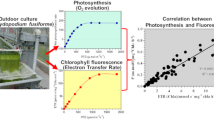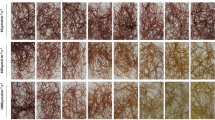Abstract
We investigated the effects of dried macroalga Gracilaria lemaneiformis (Rhodophyta) on photosynthesis of the bloom-forming microalga Chaetoceros curvisetus. C. curvisetus was cultured with different amounts of dried G. lemaneiformis under controlled laboratory conditions. We measured the photosynthetic oxygen evolution rate and established the chlorophyll a fluorescence transient (OJIP) curve coupled with its specific parameters. We observed concentration-dependent and time-dependent relationships between dried G. lemaneiformis and inhibition of photosynthesis in C. curvisetus. Co-culture with dried G. lemaneiformis also resulted in a decrease in the light-saturated maximum photosynthetic oxygen evolution rate (P max) in C. curvisetus, and a decrease in the OJIP curve along with its specific parameters; the maximum photochemical efficiency of PSII (F v / F m), the amount of active PSII reaction centers per excited cross section at t=0 and t=t FM (RC/CS0 and RC/CSm, respectively), the absorption flux per excited cross section at t =0 (ABS/ CS0), and the efficiency with which a trapped exciton moves an electron into the electron transport chain (ψ 0). The dark respiration rate (R d) increased in C. curvisetus co-cultured with dried G. lemaneiformis. The JIP-test and the oxygen evolution results indicated that dried G. lemaneiformis decreased the number of active reaction centers, blocked the electron transport chain, and damaged the oxygen-evolving complex of C. curvisetus. This result indicated that dried fragments of G. lemaneiformis could effectively inhibit photosynthesis of C. curvisetus, and thus, could serve as a functional product to control and mitigate C. curvisetus blooms.
Similar content being viewed by others
References
Alamsjah M A, Hirao S, Ishibashi F. 2008. Algicidal activity of polyunsaturated fatty acids derived from Ulva fasciata and U. pertusa (Ulvaceae, Chlorophyta) on phytoplankton. J. Appl. Phycol., 20: 713–720.
Appenroth K J, Stöckel J, Srivastava A, Strasser R J. 2001. Multiple effects of chromate on the photosynthetic apparatus of Spirodela polyrhiza as probed by OJIP chlorophyll a fluorescence measurements. Environ. Pollut., 115: 49–64.
Guillard R R L. 1975. Culture of phytoplankton for feeding marine invertebrates. In: Smith W L, Chanley M H eds. Culture of Marine Animals. Plenum, New York. p.26–60.
Heisler J, Glibert P M, Burkholder J M, Anderson D M, Cochlan W, Dennison W C, Dortch Q, Gobler C J, Heil C A, Humphries E, Lewitus A, Magnien R, Marshallm H G, Sellner K, Stockwell D A, Stoecker D K, Suddleson M. 2008. Eutrophication and harmful algal blooms: a scientific consensus. Harmful Alga e, 8: 3–13.
Jin Q, Dong S L. 2003. Comparative studies on the allelopathic effects of two different strains of Ulva pertusa on Heterosigma akashiwo and Alexandrium tamarense. J. Exp. Mar. Biol. Ecol., 293: 41–55.
Lu H M, Xie H H, Gong Y X, Wang Q, Yang Y F. 2011. Secondary metabolites from the seaweed Gracilaria lemaneiformis and their allelopathic effects on Skeletonema costatum. Biochem. Syst. Ecol., 39: 397–400.
Mao H, Xu H, Liu Z P, Mehta S K. 2008. Effect of initial cell density on population competition between Skeletonema costatum and Chaetoceros curvisetus. Mar. Environ. Sci., 27: 458–461. (in Chinese with English abstract)
Nan C R, Zhang H Z, Lin S Z, Zhao G Q, Liu X Y. 2008. Allelopathic effects of Ulva lactuca on selected species of harmful bloom-forming microalgae in laboratory cultures. Aquat. Bot., 89: 9–15.
Oh M Y, Lee S B, Jin D H, Hong Y K, Jin H J. 2010. Isolation of algicidal compounds from the red alga Corallina pilulifera against red tide microalgae. J. Appl. Phycol., 22: 453–458.
Qi Z H, Liu H M, Li B, Mao Y Z, Jiang Z J, Zhang J H, Fang J G. 2010. Suitability of two seaweeds, Gracilaria lemaneiformis and Sargassum pallidum, as feed for the abalone Haliotis discus hannai Ino. Aquaculture, 300: 189–193.
Reigosa M J, Sánchez-Moreiras A, González L. 1999. Ecophysiological approach in allelopathy. Crit. Rev. Plant Sci., 18: 577–608.
Strasser R J, Srivastava A, Govindjee. 1995. Polyphasic chlorophyll a fluorescence transient in plants and cyanobacteria. Photochem. Photobiol., 61: 32–42.
Sugawara T, Hamasaki K, Toda T, Kikuchi T, Taguchi S. 2003. Response of natural phytoplankton assemblages to solar ultraviolet radiation (UV-B) in the coastal water, Japan. Hydrobiologia, 493: 17–26.
Sun X X, Choi J K. 2004. Recovery and fate of three species of marine dinoflagellates after yellow clay flocculation. Hydrobiologia, 519: 153–165.
Tang Y Z, Gobler C J. 2011. The green macroalga, Ulva lactuca, inhibits the growth of seven common harmful algal bloom species via allelopathy. Harmful Algae, 10: 480–488.
Wang J H, Wu J Y. 2009. Occurrence and potential risks of harmful algal blooms in the East China Sea. Sci. Total Environ., 407: 4 012–4 021.
Wang Y, Yu Z M, Song X X, Tang X X, Zhang S D. 2007. Effects of macroalgae Ulva pertusa (Chlorophyta) and Gracilaria lemaneiformis (Rhodophyta) on growth of four species of bloom-forming dinoflagellates. Aquat. Bot., 86: 139–147.
Wang Y, Zhou B, Tang X X. 2009. Effects of macroalga Gracilaria lemaneiformis on growth of Heterosigma akashiwo (Raphidophyceae). J. Appl. Phycol., 21: 375–385.
Wellburn A R. 1994. The spectral determination of chlorophylls a and b, as well as total carotenoids, using various solvents with spectrophotometers of different resolution. J. Plant Physiol., 144: 307–313.
Wium-Andersen S, Anthoni U, Christophersen C, Houen G. 1982. Allelopathic effects on phytoplankton by substances isolated from aquatic macrophytes (Charales). Oikos, 39: 187–190.
Xu J T, Gao K S. 2008. Growth, pigments, UV-absorbing compounds and agar yield of the economic red seaweed Gracilaria lemaneiformis (Rhodophyta) grown at different depths in the coastal waters of the South China Sea. J. Appl. Phycol., 20: 681–686.
Zheng Y Q, Gao K S. 2009. Impacts of solar UV radiation on the photosynthesis, growth, and UV-absorbing compounds in Gracilaria lemaneiformis (Rhodophyta) grown at different nitrate concentrations. J. Phycol., 45: 314–323.
Zhou Y, Yang H, Hu H, Liu Y, Mao Y Z, Zhou H, Xu X L, Zhang F S. 2006. Bioremediation potential of the macroalga Gracilaria lemaneiformi s (Rhodophyta) integrated into fed fish culture in coastal waters of north China. Aquaculture, 252: 264–276.
Zhu J Y, Liu B Y, Wang J, Gao Y N, Wu Z B. 2010. Study on the mechanism of allelopathic influence on cyanobacteria and chlorophytes by submerged macrophyte (Myriophyllum spicatum) and its secretion. Aquat. Toxicol., 98: 196–203.
Author information
Authors and Affiliations
Corresponding author
Additional information
Supported by the National Key Technology R&D Program (No. 2012BAC07B05), the National Natural Science Foundation of China (No. 31000240), and the Project on the Integration of Industry, Education and Research of Guangdong Province (No. 2012B091100341)
Rights and permissions
About this article
Cite this article
Ye, C., Zhang, M. & Yang, Y. Inhibition of photosynthesis in the microalga Chaetoceros curvisetus (Bacillariophyta) by macroalga Gracilaria lemaneiformis (Rhodophyta). Chin. J. Ocean. Limnol. 31, 1174–1180 (2013). https://doi.org/10.1007/s00343-013-2093-3
Received:
Accepted:
Published:
Issue Date:
DOI: https://doi.org/10.1007/s00343-013-2093-3




